SPECIAL RELATIVITY
For the Enthusiastic Beginner
David Morin
Harvard University
David Morin 2017
All rights reserved
ISBN-10: 1542323517
ISBN-13: 978-1542323512
Cover image: iStock photograph by Andrey Armyagov
Additional resources located at:
www.people.fas.harvard.edu/~djmorin/book.html
Contents
Preface
Einsteins theory of relativity is one of the most exciting and talked-about subjects in physics. It is well known for its paradoxes, which often lead to intense and animated discussions. There is, however, nothing at all paradoxical about it. The theory is logically and experimentally sound, and the whole subject is actually quite straightforward, provided that one proceeds calmly and keeps a firm hold of ones wits.
This book is a revised and expanded version of the last four chapters in my textbook Introduction to Classical Mechanics, with Problems and Solutions (Cambridge University Press, 2008). A great deal of additional commentary has been included in order to make the book accessible to a wider audience. This new version assumes a mild familiarity with standard Newtonian physics (often called freshman physics). More precisely, the first two chapters (on kinematics) assume very little prior physics knowledge; there is no mention of force, energy, momentum, etc. But and onward assume a bit more, although still not a huge amount. (Appendix E gives a quick review of force, etc., for readers with a limited physics background.) The nice thing (or not-so-nice thing, depending on your point of view) about relativity is that it is challenging due to its inherent strangeness, as opposed to a heavy set of physics prerequisites. Likewise for the math prerequisite: calculus is used on a few occasions, but it isnt essential to the overall flow of the book. Generally, all that is required is standard algebra.
If you happen to have a strong background in standard Newtonian physics, then you might be in for a shock, because relativity is where you discover that most of what you know about physics is wrong. Or perhaps incomplete would be a better word. The important point to realize is that Newtonian physics is a limiting case of the more correct relativistic theory. Newtonian physics works perfectly fine when the speeds youre dealing with are much less than the speed of light. Indeed, it would be silly to use relativity to solve a problem involving the length of a baseball trajectory. But in problems involving large speeds, or in problems where a high degree of accuracy is required, you must use the relativistic theory.
Of course, relativity isnt the end of the story either. In your future physics studies, you will eventually discover that classical special relativity (the subject of this book) is similarly the limiting case of another theory (quantum field theory). And likewise, quantum field theory is the limiting case of yet another theory (string theory). And likewise well, you get the idea. Who knows, maybe it really is turtles all the way down.
There are two main topics in relativity; special relativity (which doesnt deal with gravity) and general relativity (which does). Well deal mostly with the former, although . Among the topics covered are a collection of qualitative relativity questions and answers (Appendix A), a review of nonrelativistic dynamics (Appendix E), and strategies for solving problems (Appendix F).
I have included a large number of puzzles/paradoxes in the problems and exercises. (Problems have solutions included. Exercises do not, so that they can be used for homework assignments.) When attacking these, be sure to follow them through to completion, and dont say, I could finish this one if I wanted to, but all Id have to do would be such-and-such, so I wont bother, because the essence of the paradox may very well be contained in the such-and-such, and you will have missed out on all the fun. Most of the paradoxes arise because different frames of reference seem to give different results. Therefore, in explaining a paradox, you not only need to give the correct reasoning, you also need to say whats wrong with incorrect reasoning.
The difficulty of the problems and exercises is indicated by stars (actually asterisks). One star means fairly straightforward, while four stars mean diabolically difficult. Two stars are the most common. Be sure to give a solid effort when solving a problem, and dont look at the solution too soon. If you cant solve a problem right away, thats perfectly fine. Just set it aside and come back to it later. Its better to solve a problem later than to read the solution now. If you do eventually need to look at a solution, cover it up with a piece of paper and read one line at a time, to get a hint to get started. Then set the book aside and work things out for real. That way, you can still (mostly) solve it on your own. You will learn a great deal this way. If you instead head right to the solution and read it straight through, you will learn very little. Be warned that the four-star and some of the three-star problems are extremely difficult. Even if you understand everything in the text, that doesnt mean you should be able to solve every problem right away (as I can attest to!).
For your reading pleasure (I hope!), I have included limericks throughout the text. Although these might be viewed as educational, they certainly dont represent any deep insight I have into the teaching of physics. I have written them for the sole purpose of lightening things up. Some are funny. Some are stupid. But at least theyre all physically accurate (give or take).
A few informational odds and ends: This book contains many supplementary remarks that are separated off from the main text; these end with a shamrock,  . The letter denotes the ratio of v to c; that is, v/c. We will often drop the cs in calculations, lest things get too messy. The cs can always be brought back in at the end, by putting them where they need to go in order to make the units correct. Fractions like L/v are understood to mean L/(v), and not (L/)v. Although the latter is technically correct, people generally assume the L/(v) meaning. I will often use an s to indicate the plural of one-letter items (like the ms of particles). I will unabashedly construct unrealistic scenarios where people run at speed 3c/5, etc. And I will frequently be grammatically sloppy and use the phrase clocks run slow instead of clocks run slowly.
. The letter denotes the ratio of v to c; that is, v/c. We will often drop the cs in calculations, lest things get too messy. The cs can always be brought back in at the end, by putting them where they need to go in order to make the units correct. Fractions like L/v are understood to mean L/(v), and not (L/)v. Although the latter is technically correct, people generally assume the L/(v) meaning. I will often use an s to indicate the plural of one-letter items (like the ms of particles). I will unabashedly construct unrealistic scenarios where people run at speed 3c/5, etc. And I will frequently be grammatically sloppy and use the phrase clocks run slow instead of clocks run slowly.
I would like to thank Carey Witkov for meticulously reading through the entire book and offering many valuable suggestions, and Jacob Barandes for numerous illuminating discussions. Other friends and colleagues whose input I am grateful for are Andrzej Czarnecki, Carol Davis, Howard Georgi, Brian Hall, Theresa Morin Hall, Don Page, and Alexia Schulz. I would also like to thank the students in my Special Relativity course in Harvard Universitys Pre-College Program in the summer of 2016. The lively discussions were very helpful in fine-tuning the presentation of many topics throughout the book.
For instructors using this book as the assigned textbook for a course, a solutions manual for the exercises is available upon request. When sending a request, please point to a syllabus and/or webpage for your course.
Despite careful editing, there is zero probability that this book is error free. If anything looks amiss, please check www.people.fas.harvard.edu/~djmorin/book.html for a list of typos, updates, additional material, etc. And please let me know if you discover something that isnt already posted. Suggestions are always welcome.


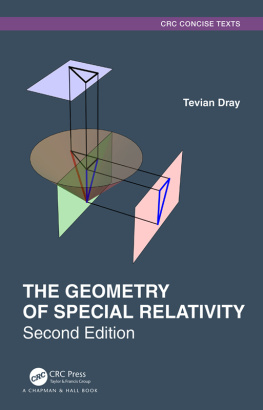
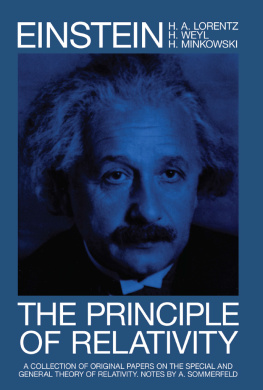
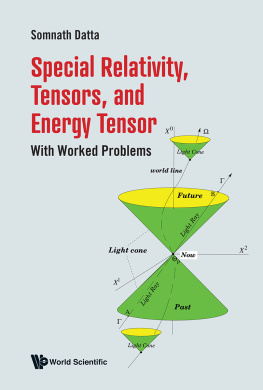

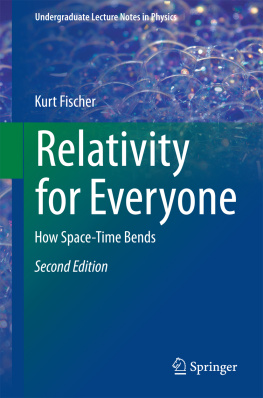
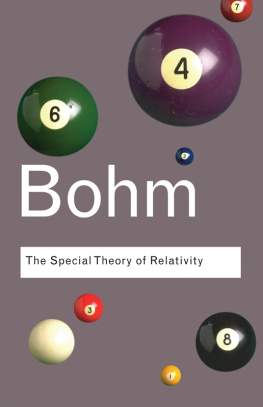
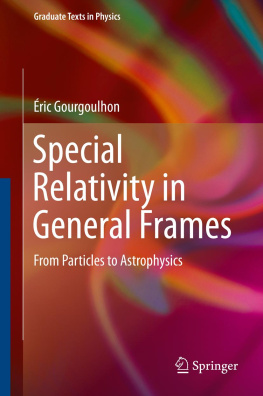
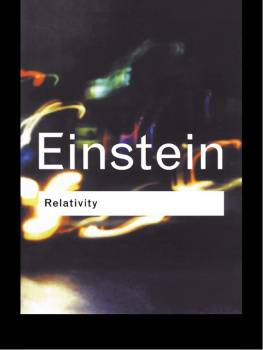
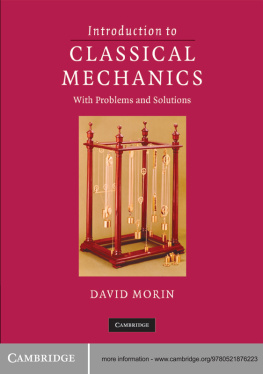
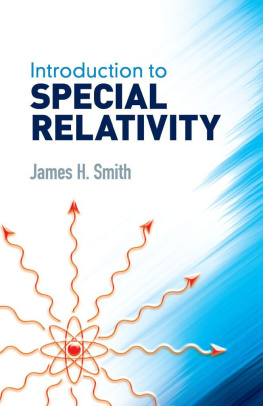

 . The letter denotes the ratio of v to c; that is, v/c. We will often drop the cs in calculations, lest things get too messy. The cs can always be brought back in at the end, by putting them where they need to go in order to make the units correct. Fractions like L/v are understood to mean L/(v), and not (L/)v. Although the latter is technically correct, people generally assume the L/(v) meaning. I will often use an s to indicate the plural of one-letter items (like the ms of particles). I will unabashedly construct unrealistic scenarios where people run at speed 3c/5, etc. And I will frequently be grammatically sloppy and use the phrase clocks run slow instead of clocks run slowly.
. The letter denotes the ratio of v to c; that is, v/c. We will often drop the cs in calculations, lest things get too messy. The cs can always be brought back in at the end, by putting them where they need to go in order to make the units correct. Fractions like L/v are understood to mean L/(v), and not (L/)v. Although the latter is technically correct, people generally assume the L/(v) meaning. I will often use an s to indicate the plural of one-letter items (like the ms of particles). I will unabashedly construct unrealistic scenarios where people run at speed 3c/5, etc. And I will frequently be grammatically sloppy and use the phrase clocks run slow instead of clocks run slowly.